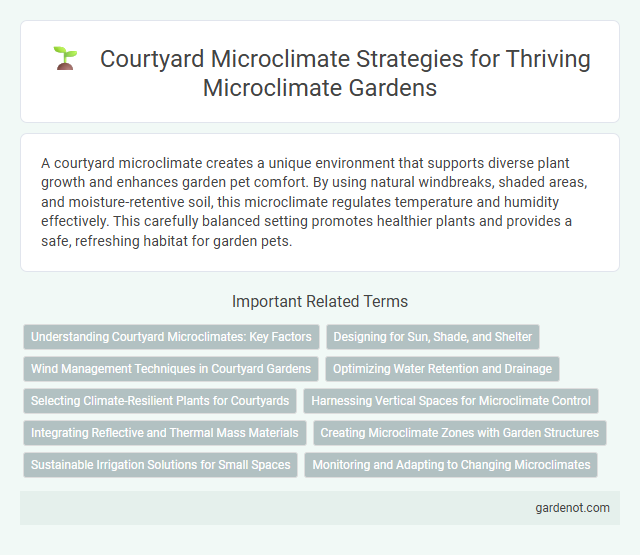A courtyard microclimate creates a unique environment that supports diverse plant growth and enhances garden pet comfort. By using natural windbreaks, shaded areas, and moisture-retentive soil, this microclimate regulates temperature and humidity effectively. This carefully balanced setting promotes healthier plants and provides a safe, refreshing habitat for garden pets.
Understanding Courtyard Microclimates: Key Factors
Courtyard microclimates are shaped by factors such as solar exposure, wind patterns, and surrounding building materials, which influence temperature and humidity levels. Sunlight duration and intensity affect heat retention, while walls and vegetation provide shade and wind protection, moderating the microclimate. Understanding these elements helps optimize plant selection and placement to create a balanced and sustainable garden environment.
Designing for Sun, Shade, and Shelter
Designing a courtyard microclimate involves strategically balancing sun exposure, shade, and shelter to create a comfortable outdoor environment. Incorporating elements like deciduous trees for seasonal shade, pergolas for filtered sunlight, and windbreaks such as hedges or walls enhances temperature regulation. Selecting heat-tolerant plants alongside shaded seating areas optimizes comfort while reducing energy consumption in adjacent buildings.
Wind Management Techniques in Courtyard Gardens
Effective wind management techniques in courtyard microclimate gardens optimize airflow to protect delicate plants and enhance comfort. Strategic placement of windbreaks such as hedges, trellises, and pergolas reduces wind speed and turbulence within the enclosed space. Incorporating dense shrubbery and layered vegetation creates a natural barrier that moderates wind impact, improving overall microclimate conditions.
Optimizing Water Retention and Drainage
In courtyard microclimates, optimizing water retention and drainage is essential for sustaining plant health and preventing soil erosion. Techniques such as incorporating permeable paving, using organic mulches, and installing French drains enhance water infiltration and reduce surface runoff. Strategic plant placement with drought-tolerant species and rain gardens further improves moisture management and microhabitat stability.
Selecting Climate-Resilient Plants for Courtyards
Selecting climate-resilient plants for courtyard microclimates enhances sustainability by withstanding temperature fluctuations and limited sunlight. Native species such as lavender, succulents, and dwarf olive trees thrive in restricted spaces while conserving water and preventing soil erosion. Incorporating drought-tolerant and shade-adapted varieties ensures year-round greenery and reduces maintenance in enclosed courtyard environments.
Harnessing Vertical Spaces for Microclimate Control
Courtyard microclimates benefit significantly from harnessing vertical spaces, such as walls and trellises, which optimize thermal regulation and airflow. Vertical gardens and climbing plants improve humidity control and shade, reducing heat buildup while enhancing biodiversity. Strategic placement of vegetation on vertical structures creates insulating barriers that stabilize temperature fluctuations within the courtyard space.
Integrating Reflective and Thermal Mass Materials
Integrating reflective and thermal mass materials in a courtyard microclimate enhances temperature regulation by minimizing heat absorption during the day and releasing warmth at night. Reflective surfaces, such as light-colored stones or metals, reduce solar heat gain, while thermal mass elements like concrete or brick absorb and store heat, stabilizing ambient temperatures. This combination supports energy efficiency and creates a comfortable environment for plants and occupants by balancing heat fluctuations naturally.
Creating Microclimate Zones with Garden Structures
Garden structures such as pergolas, green walls, and shade sails play a crucial role in creating distinct microclimate zones within courtyard gardens by regulating sunlight, wind flow, and humidity levels. These features help retain heat during cooler months and provide cooling shade during hot periods, optimizing comfort for plants and people alike. Strategically placed trellises and water features further enhance localized humidity and airflow, fostering diverse microclimate pockets that support varied plant species and ecological balance.
Sustainable Irrigation Solutions for Small Spaces
Sustainable irrigation solutions for courtyard microclimates prioritize water efficiency through drip irrigation and rainwater harvesting systems, which reduce waste and conserve resources in limited garden spaces. Integrating smart sensors and moisture meters ensures precise watering tailored to plant needs, minimizing overwatering and promoting healthy growth. Native and drought-tolerant plants further enhance sustainability by requiring less frequent irrigation, creating an eco-friendly microclimate in small courtyards.
Monitoring and Adapting to Changing Microclimates
Courtyard microclimates experience fluctuations influenced by factors such as sunlight exposure, wind patterns, and humidity levels. Monitoring these parameters through sensors and environmental data helps optimize plant selection and irrigation schedules tailored to specific microclimate conditions. Adaptive strategies, including adjustable shading systems and moisture retention techniques, enhance plant resilience and promote sustainable courtyard garden health.
Courtyard microclimate Infographic

 gardenot.com
gardenot.com